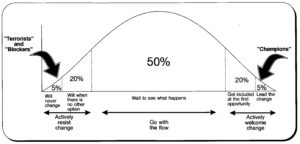
On Technology Leadership and Change Challenges
I was interviewed for a local blog article on Information Technology and the leadership challenges of integrating with business, managing change, and risk. I believe it’s worthwhile to share some of those thoughts here.
Q: How do go about applying technology to solve business challenges?
A: When I think about solving challenges in the business, it’s never simply one thing, e.g. technology, that solves the problem. The solution always comes about through a combination of people, process, and tools. Technology is simply a tool. A tool can be purchased and implemented in an afternoon. Think about going to the hardware store and purchasing a hammer and nails; in the hands of a person who’s never used a hammer before all you will get is a swollen thumb and a piece of wood with a bunch of bent nails. However, in the hands of a skilled craftsman, you will get the cathedral Notre-Dame de Paris. So the craftsman (people) have the motivation, and ability, to choose the correct hammer (the tool) and select the right nails and material and know how to use the hammer and material (the process).
If we think about change adoption it looks like a bell curve; with 25% of people championing change; and 25% actively resisting change; then there’s the 50% on the fence. Yet as managers; where do we spend most of our time? On the bottom 25%; attempting to “convince” them to come along. Taking such an approach alienates the champions “we’re working so hard and not getting kudos and they are stalling progress”; and shifts the middle 50% to becoming blockers resisting change, “If they are having to drag that many people along, this change can’t possibly be a good thing”.
We should be spending our change efforts to working and fostering the ‘super man/woman” in the top 25% and top half of the middle 50%, the blockers will either come along because of peer pressure or simply leave the business.
Q: How do you go about convincing business leadership to make major technology investments?
A: There have been very few times in my career where I’ve had to “convince” senior leadership of anything. If IT has a seat at the executive table; and access to the board of directors; and IT is actively engaged in the strategic planning process of the business; the required objectives and commensurate people, process, and tools becomes self-evident through the organic planning process.
In those cases where something arises that requires a major investment, and it’s out of the planning cycle, e.g. an acquisition or some other event; again, the need and commensurate people, process and tools are self-evident.
If I am in a position of having to “convince” or “sell” anything to senior leadership, one of two things is not occurring and need drastic change; either IT is not included in the overall planning process of the business and sitting at the table; or I am not listening to the strategic needs of the business and aligning technology services accordingly.
Q: What are some of the most important skills when evaluating and making staffing decisions?
A: While some people believe that a person having an exceptional technical acumen is the most important attribute. Flexibility and adaptability are far more important overall; many technical skills can be taught; if you are an engineer who understands object oriented design, learning the differences between C# and Java are a matter of semantics. However if you don’t possess the ability to be flexible enough to adapt to changes from a structured design model, to an object oriented model then no amount of skill development can compensate for the deficiency.
When it comes down to people, I look at three things; do they have the desire or drive to accomplish something, do they have an amount of ability to accomplish something in a reasonable time, and do they have the opportunity to accomplish something. I can provide the opportunity, and I can provide the tools to help build the ability to some degree. I cannot provide the drive and desire.
Q: How do you decide on what technology investments to make; if it’s new and emerging technology, and how do you go about managing that risk?
A: While there are some non-negotiables in the technology investment cycle; e.g. licensing (if you use it, you pay for it). Every decision about investment should be made through the lens of strategic alignment or returns provided to the business (even if they are soft or cost avoidance). In cases where I haven’t performed adequate due diligence on the investment; risk avoidance becomes a paramount concern.
When we implement technology solutions for a business, unless the business is in the technology development sector, technology should never be implemented for technologies sake; most businesses are not in the technology business, so the use of investments should be primarily focused as a lever to drive revenue (top line) growth; e.g. an eCommerce solution that would generate sales, or improve efficiency and thus increasing organizational bandwidth and reducing operating expense; e.g. ERP.
While there is always risk in any investment; managing the risk is primarily about insuring that you not only identify the big risks; e.g. project change, or change adoption; but just as important managing the incremental day to day risks; competing priorities, lack of clear direction. While in many cases the day to day risks are easier to manage largely because they are incremental; many times they are not managed well (how many times during the course of project work you procrastinate on a detail because you simply “don’t feel like it” or a conversation is too much of a pain in the neck because of another stakeholder – because, you know, it’s always the other person and not me who’s the problem).
Not addressing the day to day risks will accumulate over time and create significant project delays, and cost overruns. So I handle these types of issues using regular cadence meetings with only three agenda items (taking from the Chesney book ‘The 4 Disciplines of Execution’):
- What was accomplished on the objectives from the last reporting period?
- What items need to be accomplished in the upcoming reporting period to move the needle on the project?
- What are the roadblocks preventing the person from completing the upcoming reporting period?
The reality is that in any leadership position, our jobs involve us becoming the CRRO – the Chief Roadblock Removal Officer for the stakeholders, teammates, and direct reports we serve.
In Summary
Most of the topics I was asked about during the interview were things I don’t really think about anymore and have, for me, become a matter of habit. Someone pointed out to me that not everyone understands what I do, so sharing these experiences would be beneficial for leaders struggling with the same thing.
I hope you find the information useful.

